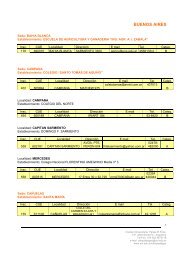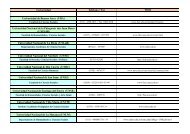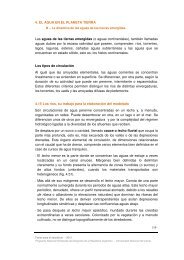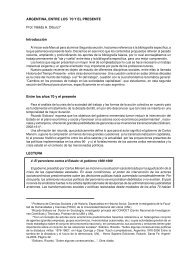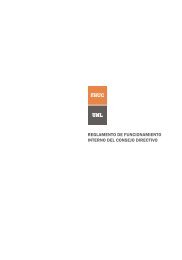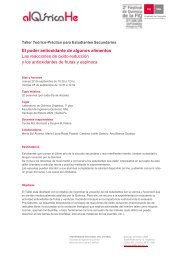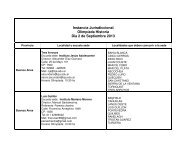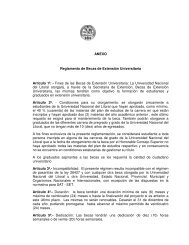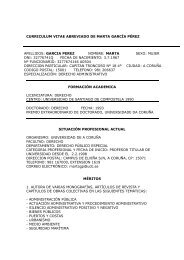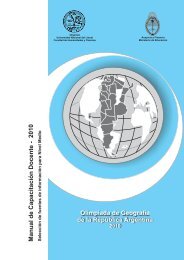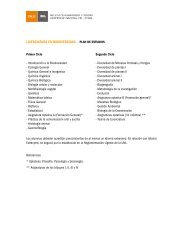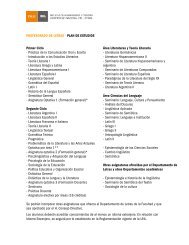+Info - Universidad Nacional del Litoral
+Info - Universidad Nacional del Litoral
+Info - Universidad Nacional del Litoral
Create successful ePaper yourself
Turn your PDF publications into a flip-book with our unique Google optimized e-Paper software.
Curso de posgrado<br />
Profesor/es Profesor/es dictante/s:<br />
dictante/s:<br />
Formas Formas Formas de de la la Intertextualidad Intertextualidad en en la la literatura literatura grecolatina<br />
grecolatina<br />
Dr. Guillermo De Santis; Dr. Marcos Carmignani y Dra. Ivana Chialva.<br />
<strong>Universidad</strong> <strong>Universidad</strong> de de origen origen origen de de cada cada profesor profesor dictante dictante: dictante<br />
Dr. Guillermo De Santis (<strong>Universidad</strong> <strong>Nacional</strong> de Córdoba-CIECSConicet)<br />
Dr. Marcos Carmignani (<strong>Universidad</strong> <strong>Nacional</strong> de Córdoba-CIECSConicet)<br />
Dra. Ivana Chialva (<strong>Universidad</strong> <strong>Nacional</strong> <strong>del</strong> <strong>Litoral</strong>-CIECSConicet)<br />
Fechas Fechas de de de dictado: dictado: Lunes 27, martes 28, miércoles 29 y jueves 30 de mayo<br />
Horari Horarios: Horari Horarios:<br />
os: 27, 28 y 29 de mayo de 9 a 17.30; 30 de mayo de 9 a 13:30.<br />
Duración: Duración: Cuarenta y cinco (45) horas. Treinta (30) horas presenciales; quince (15) horas para consultas y<br />
evaluación<br />
Créditos Créditos académicos: académicos: 3 (tres) créditos<br />
Destinatarios:<br />
Destinatarios:<br />
Interesados en los Estudios Clásicos con especificidades diferentes. Profesores y Licenciados de la carrera<br />
de Letras y de Filosofía. Estudiantes de grado avanzados.<br />
Requisitos:<br />
Requisitos:<br />
La temática <strong>del</strong> curso exige un conocimiento de latín y griego clásicos. En el caso de que los interesados no<br />
contaran con ese conocimiento, deberán utilizar las traducciones consignadas por los docentes.<br />
Objetivos:<br />
Objetivos:<br />
*Generales:<br />
- Estudiar las diferentes teorías y perspectivas intertextuales, tanto de la Antigüedad clásica como de la<br />
modernidad.<br />
- Reconocer la posición de un autor frente a la tradición literaria y cultural a través de las estrategias<br />
intertextuales que dispone en su obra.<br />
*Específicos:
- Analizar intertextualmente los diferentes textos seleccionados con la finalidad de explicar las<br />
consecuencias de la alusión, sobre todo en cuanto a la economía narrativa y el posicionamiento dentro de<br />
una tradición literaria prestigiosa.<br />
- Distinguir los medios expresivos intertextuales que permiten a Teócrito ofrecer su producto poético a la<br />
élite y que generan una imagen <strong>del</strong> «poeta» como el más apto para la reutilización de la tradición en<br />
diversas funciones.<br />
- Distinguir los «tipos» de centones, reconocer sus medios expresivos y las funciones que poseen en mundo<br />
cultural de la antigüedad tardía.<br />
- Identificar e interpretar las estrategias intertextuales en las Eikones de Filóstrato, donde la palabra de la<br />
tradición clásica permite reinterpretar ese legado cultural según los cánones visuales y sofísticos de los<br />
autores <strong>del</strong> Imperio.<br />
Contenidos:<br />
Contenidos:<br />
Ejes temáticos y/o contenidos conceptuales a desarrollar:<br />
1. -La intertextualidad en la antigüedad clásica: los conceptos de µ µησις e imitatio. Las perspectivas de<br />
Dioniso de Halicarnaso, Longino y Quintiliano. El concepto moderno de intertextualidad: diversas teorías,<br />
desde Eliot y Borges hasta Genette. La intertextualidad dentro de los estudios clásicos: Pasquali,<br />
Giangrande, Conte, Hinds y Finkelpearl. El tratamiento de la parodia en la antigüedad y en la modernidad:<br />
nuevas perspectivas. El problema de la intención <strong>del</strong> autor. Ejemplos paradigmáticos de imitatio en la<br />
literatura grecolatina.<br />
2. Téocrito: la «invención» <strong>del</strong> género bucólico. El mundo helenístico y la «nueva poesía". El estudio de la<br />
tradición literaria como objeto de cultural y como formación poética. Homero, un mo<strong>del</strong>o a respetar, usar y<br />
desoír. El encomio como forma poética: Píndaro y la tradición de la poesía dedicada. La intertextualidad<br />
irreverente de Teócrito: el nuevo hexámetro, viejos y nuevos tópicos literarios y le negación de Homero como<br />
«el todo de la poesía griega". Análisis intertexual de los Idilios 16 y 17.<br />
3. Los centones: La convivencia de sistemas culturales, tardoantigüedad latina y cristianismo. La<br />
intertextualidad extrema. Tradición centonaria grecolatina y los centones virgilianos. Los límites de la<br />
alusión y la cita intertextuales. Recombinación centonaria y la generación de sentidos poéticos. Tipos de<br />
centones.Análisis intertextual de Cento Nuptialis de Ausonio, la Medea de Hosidio Geta y el centón cristiano<br />
de Proba (Cento Vergilianus De Laudibus Christi).<br />
4. Filostrato: la ékfrasis, una forma literaria autónoma. La cualidad de la enargeia en el contexto de la<br />
retórica grecorromana. Reflexiones acerca de la eikón en tanto huella sensible de la mente, desde Gorgias<br />
hasta Quintiliano y el Pseudo Longino. La intertextualidad como composición de la eikón sofística y<br />
fundamento de la cultura visual subyacente en la prosa filostratea. Léxis poietiké: la segunda sofística y la<br />
herencia de Gorgias. Fundamento teórico-estético de la mímesis: la mímesis que imita a la naturaleza que<br />
imita a la grafé. Conjugación de la mímesis literaria, sofística y pictórica en las grafai (pinturas-escrituras)<br />
de las Imágenes.
Bibliografía:<br />
Bibliografía:<br />
-Ediciones y Traducciones:<br />
Clark, E., Hatch, D. (1981)The golden bough, the oaken cross. The virgilian Cento of Faltonia Betitia Proba,<br />
California.<br />
Conte, G.B. (2009)P. Vergilius Maro: Aeneis, Berlin.<br />
Cuenca, L.A. y Elvira, M.A. Filóstrato el viejo; Filóstrato el joven, Calístrato. Imágenes. Descripciones. Madrid,<br />
1993.<br />
Evelyn-White, H. G. (1919) Ausonius, 2 vols., London & New York.<br />
García Teijeiro, M., Molinos Tejada, T. (1986) Bucólicos Griegos. Traducción de . Gredos.<br />
Gow, A.S. (1973) Theocritus, edited with Translation and Commentary. Oxford.<br />
Green, R.P.H. (ed.) (1999) Decimi Magni Ausonii Opera, Oxford.<br />
Green, R.P.H. (1991) The Works of Ausonius, Oxford.<br />
Huemer, J. (ed.) (1891) Poetae Christiani Minores (CSEL 24), Vidobonae.<br />
Kaczynski, B. (2002) “Faltonia Betitia Proba: A Virgilian Cento in Praise of Christ”, en L. Churchill, Kayser,<br />
C.G. (1981) FLAVII PHILOSTRATI . Opera. Auctiora edidit (ed. minor). Vol. II. Hildesheim, 1964.<br />
P. Brown, J. Jeffrey (eds.), Women Writing Latin. From Roman Antiquity to Early Modern Europe, vol. 1, New<br />
York and London. pp. 131-148.<br />
LaFico Guzzo, M, Carmignani, M. (2012) Proba: Cento Vergilianus De Laudibus Christi - Ausonius: Cento<br />
Nuptialis, Bahía Blanca.<br />
Lamacchia, R. (1981) Hosidius Geta: Medea Cento Vergilianus, Leipzig.<br />
Lemaire, N. (1826) Poetae latini minores, vol. VII, Paris.<br />
Mestre, F. Filóstrato el viejo, Filóstrato el joven y Calístrato. Heroico, Gimnástico. Descripciones de cuadros.<br />
Descripciones. Madrid, 1996.<br />
Meyer, H. (ed.) (1835), Anthologia Latina, Lipsiae.<br />
Montero Cartelle, E. (1981) Priapeos. Grafitos amatorios pompeyanos. La velada de la fiesta de Venus. El<br />
concúbito de Marte y Venus. Centón nupcial, Madrid.<br />
Mynors, R. A. B. (1969) Virgilii Maronis Opera, Oxford.<br />
Palumba Stracca, B. (1999) Teocrito. Idilli ed epigrammi, a cura di, BUR.<br />
Plant, I (ed.) (2004) Women Writers of Ancient Greece and Rome: An Anthology, Oklahoma. pp. 170-188.<br />
Reedy, J. (1981) “Proba’s Cento”, en P. Wilson-Kastner et alii, A Lost Tradition. Women Writers of the Early<br />
Church, Lanham-New York-London. pp. 45-69.<br />
Riese, A., Buecheler, F (eds.) (1884) Anthologia Latina, sive poesis Latinae supplementum, pars prior,<br />
Carmina in codicibus scripta, fasciculus I, Libri Salmasiani aliorumque carmina, fasciculus II, Reliquorum<br />
librorum carmina, Lipsiae.<br />
Salanitro, G.Osidio Geta. (1981) Introduzione, testo critico, traduzione ed indici, Roma.
Schenkl, C. (ed.) (1883) D. Magni Ausonii Opuscula, en Monumenta Germaniae Historica. Auctorum<br />
antiquissimorum tomi V pars posterior, Berolini.<br />
Schenkl, C. (ed.) (1888) Poetae Christiani Minores (CSEL 16), Pragae-Vidobonae-Lipsiae.<br />
-Bibliografía Crítica:<br />
Adams, J. N. (1981) “Ausonius, ‘Cento Nuptialis’”, SIFC 53. pp. 199-215.<br />
Adams, J. N. (1982) The Latin Sexual Vocabulary, London.<br />
Allen, W. (1940) ‘The Epyllion: a chapter in the history of literary criticism’, TAPA 71: 1–26.<br />
Andrews, N. E. (1996) ‘Narrative and allusion in Theocritus, Idyll 2’ in Theocritus, ed. M. A. Harder, R. F.<br />
Regtuit, G. C. Wakker. Groningen. Pp. 21–53.<br />
Austin, N. (1967) ‘Idyll 16: Theocritus and Simonides’ TAPA 98 (1967): 1–21.<br />
Auerbach, E. (1950) Mimesis. La representación de la realidad en la literatura occidental, México.<br />
Bajtín, M. (1989), Teoría y estética de la novela, Madrid.<br />
Barchiesi, A. (1995), “Figure <strong>del</strong>l’intertestualità nell’epica romana”, Lexis 13: 49-67.<br />
Barchiesi, A. (1997), “Otto punti su una mappa dei naufragi”, MD 39: 209-226.<br />
Barthes, R. (1968), “La morte de l’auteur” en Barthes, R. (1984), Le bruissement de la langue (1984), Paris.<br />
Bartsch,S.; Elsner,J. (Eds.). Special Issues on Ekphrasis. Classical Philology. N° 102, 2007.<br />
Bažil, M. Centones Christiani. Métamorphoses d’une forme intertextuelle dans la F. poésie latine chrétienne<br />
de l’Antiquité tardive, Paris, 2009.<br />
Ben-Porat, Z. (1976), “The Poetics of Literary Allusion”, PTL: A Journal for Descriptive Poetics and Theory of<br />
Literature 1. Pp. 105-128.<br />
Ben-Porat, Z. (1979), “Method in Madness: Notes on the Structure of Parody, Based on MAD TV Satires”,<br />
Poetics Today 1. Pp. 245-272.<br />
Blanchard, M. (1986) “Problemes du texte et du tableau: les limites de l´ imitation á l´ époque hellénistique<br />
et sous l´ Empire”. En Cassin, B. (ed.), Le plaisir de parler. París, p. 131- 154.<br />
Bloom, H. (1973), The Anxiety of Influence: A Theory of Poetry, New York.<br />
Bonaria, M. (1971) “Appunti per la storia <strong>del</strong>la tradizione vergiliana nel IV secolo.”, en H. Bardon, R. Verdière<br />
(eds.), Vergiliana: Recherches sur Virgile, Leiden. pp. 35-40.<br />
Bowie, E. L. (1985) ‘Theocritus’ seventh Idyll, Philetas and Longus’ CQ 35: 67–91.<br />
Bright, D. F. (1984)“Theory and Practice in the Vergilian Cento” ICS. 9. pp. 79-90.<br />
Bright, D. F. (1987) The Miniature Epic in Vandal Africa, Oklahoma.<br />
Broich, U. (1985), “Formen der Markierung von Intertextualität” en Broich, U., M. Pfister (edd.),<br />
Intertextualität. Formen. Funktionen, Tübingen. Pp. 31-47.<br />
Broich, U., M. Pfister (1985) (edd.), Intertextualität. Formen. Funktionen, Tübingen.<br />
Bulloch, A. W. (1985) ‘Hellenistic poetry’ in Cambridge History of Classical Literature: Greek Literature I ,
ed. P. Easterling, B. Knox. Cambridge. Pp. 541–621.<br />
Burnier, A. (2005) “Démonter Virgile et bâtir un classique: le Centon nuptial d’Ausone comme jeu de reconstruction”,<br />
Ítaca. Quaderns Catalans de Cultura Clàssica 21. pp. 79-93.<br />
Cacioli, M. (1969) “Adattamenti semantici e sintattici nel centone vergiliano di Proba”, SIFC 41. pp. 188-<br />
246.<br />
Camerotto, A. (1998), Le metamorfosi <strong>del</strong>la parola. Studi sulla parodia in Luciano di Samosata, Pisa-Roma.<br />
Carmignani, M. (2011), El Satyricon de Petronio. Tradición literaria e intertextualidad, Córdoba.<br />
Cassin, B. (1995) El efecto sofístico. Buenos Aires, 2008.<br />
Cataldo, A. (1979) “Il centone di Proba e la tradizione manoscritta virgiliana nel IV secolo”, en Quaderni <strong>del</strong><br />
Predipartimento di Civiltà Classiche e <strong>del</strong> Medioevo <strong>del</strong>la Facoltà di Magistero, Università di Lecce 2. pp. 95-<br />
118.<br />
Cataldo, A. (1979) “Maro mutatus in melius. Espedienti compositivi nel centone virgiliano di Proba”, en<br />
Quaderni <strong>del</strong>’Istituto di Lingue e Letterature Classiche <strong>del</strong>la Facoltà di Magistero, Università di Lecce 1. pp.<br />
17-60.<br />
Cèbe, J.-P. (1966), La caricature et la parodie dans le monde romain antique des origines à Juvénal, Paris.<br />
Charlet, J. (1988) “Aesthetic trends in Late Latin Poetry (325-410)”, Philologus 132.1. pp. 74-85.<br />
Compagnon, A. (1998), Le demon de la théorie: littérature et sens commun, Paris.<br />
Consolino, F. E. (1983) “Da Osidio Geta ad Ausonio e Proba: le molte possibilità <strong>del</strong> centone”, A&R 28. pp.<br />
133-151.<br />
Consolino, F. E. (2003) “Metri, temi e forme letterarie in Ausonio”, en F. E. Consolino (ed.), Forme letterarie<br />
nella produzione latina di IV-V secolo, Roma. pp. 147-194.<br />
Conte, G. B. (1974), Memoria dei poeti e sistema letterario, Torino.<br />
Conte, G. B. (1981), “A proposito dei mo<strong>del</strong>li in letteratura”, MD 6: 147-174.<br />
Conte, G. B. (1984), Virgilio. Il genere e i suoi confini, Milano.<br />
Conte, G. B. (1986), The Rhetoric of Imitation. Genre and Poetic Memory in Virgil and Other Latin Poets,<br />
Ithaca and London.<br />
Conte, G. B. (1994b), Genres and Readers, Baltimore.<br />
Conte, G. B. (1994c), “Concluding Remarks: ‘The Rhetoric of Imitation’ as a Rhetoric of Culture” en Conte, G.<br />
B. (1994b): 129-143, 177-178.<br />
Conte, G. B. (1999), “On the Shoulders of Giants: Progress and Perspectives in Latin Studies”, Diogenes 47:<br />
27-33.<br />
Conte, G. B., Barchiesi, A. (1998) “Imitazione e arte allusiva. Modi e funzioni <strong>del</strong>l’intertestualità”, en Lo<br />
spazio letterario di Roma antica (vol. 1: La produzione <strong>del</strong> testo), Roma. pp. 81-114.<br />
Conte, G. B., A. Barchiesi (1989), “Imitazione e arte allusiva: modi e funzioni <strong>del</strong>l’allusività” en Cavallo, G., P.<br />
Fe<strong>del</strong>i, A. Giardina. vol. I. Pp. 81-114.<br />
Conte, G. B., Most, G. (1996a), “Imitatio” en OCD.<br />
Conte, G. B. (1986) The Rhetoric of Imitation: Genre and Poetic Memory in Virgil and Other Latin Poets,
Ithaca.<br />
Coviello, A. L. (2002) “El centón: opusculum…de alieno nostrum”, Emérita70.2. pp. 321-333.<br />
Curtius, E. (1955) Literatura Europea y Edad Media Latina, México.<br />
D’Ippolito, G. (2000), “Il concetto di intertestualità nel pensiero degli antichi” en D’Ippolito, G., “Il concetto di<br />
intertestualità nel pensiero degli antichi” en Bécares, V. et al. (eds.), Intertextualidad en las literaturas griega<br />
y latina, Madrid. Pp. 13-32.<br />
de Jong, I., J. P. Sullivan (1994) (edd.), Modern Critical Theory and Classical Literature, Leiden.<br />
DLFAC= A. Blaise (1954), Dictionnaire latin-français des Auteurs Chrétiens, Tournhout.<br />
Dodds, E. R. Paganos y cristianos en una época de angustia, Madrid, 1975 (1ª ed. London, 1968).<br />
Dover, K. (1996), “Parody (Greek)” en OCD.<br />
Dubel, S. (1997) “Ekphrasis et enargeia: la description antique comme parcours”. En Lévy, C; Pernot, L.<br />
(eds.), Dire l´évidence. (Philosophie et rhétorique antiques). Cahiers de philosophie de l´Université de Paris<br />
XII, N° 2. París, p. 249- 264.<br />
Dubel, S. (2009) “Colour in Philostratus' Imagines”. En Bowie, E.; Elsner, J. (eds.) Philostratus. New York, p.<br />
309- 321.<br />
Dubois, P. “Reading the writing on the wall” in Bartsch, Elsner (eds.), 2007, p. 45- 5.<br />
Edmunds, L. (1995), “Intertextuality Today”, Lexis 13: 3-22.<br />
Edmunds, L. (2001), Intertextuality and the Reading of Roman Poetry, Baltimore.<br />
Ehrling, S. De inconexis continuum: A Study of the Late Antique Latin wedding centos, Göteborg, 2011.<br />
Eliot, T. S. (1975), “Tradition and the Individual Talent” en Selected Prose of T. S. Eliot, New York (primera<br />
edición en The Sacred Wood, 1920).<br />
Elsner, J. Roman Eyes. Visuality and Subjectivity in Art and Text. New Jersey, 2007.<br />
Ermini, F. Il centone di Proba e la poesia centonaria latina, Roma, 1909.<br />
Fantuzzi, M. (1995) ‘Mythological paradigms in the bucolic poetry of Theocritus’, PCPS 41: 16–35.<br />
Fantuzzi, M., Hunter, R. L. (2004) Tradition and Innovation in Hellenistic Poetry. Cambridge.<br />
Fassino, M., Prauscello, L. (2001) ‘Memoria ritmica e memoria poetica: Saffo e Alceo in Teocrito Idilli 28–30<br />
tra aqvaiokoci! a e innovazione alessandrina’, MD 46: 9–37.<br />
Farrell, J. (1991), Vergil’s Georgics and the Traditions of Ancient Epic: The Art of Allusion in Literary History,<br />
New York and Oxford.<br />
Farrell, J. (1993), “Allusions, Delusions and Confusions: A Reply”, EA 1.6, http://scholar.lib.vt. edu/ejournals<br />
/ElAnt/V1N6/farrell.html.<br />
Farrell, J. (1995), E-mail enviado a los alumnos <strong>del</strong> curso de Virgilio, http://vergil.classics.upenn.edu.<br />
Farrell, J. (1997), “The Virgilian Intertext”, en Martindale, C. (1997) (ed.), The Cambridge Companion to Virgil,<br />
Cambridge: 222-238.<br />
Fassina, A. “Alterazioni semantiche ed espedienti compositivi <strong>del</strong> Cento Probae”, en Incontri triestini di<br />
filologia classica 5, 2005-2006, pp. 261-272.<br />
Finkelpearl, E. (1990), “Psyche, Aeneas, and an Ass, Apuleius Metamorphoses 6.10-6.21”, TAPhA 120: 333-
347.<br />
Finkelpearl, E. (1998), Metamorphosis of Language in Apuleius: A Study of Allusion in the Novel, Ann Arbor.<br />
Florio, R. “Virgilio después de Virgilio”, en L. Galán, M. D. Buisel (eds.), Itinera. Homenaje al Dr. Alberto J.<br />
Vaccaro, La Plata, 2011, pp. 181-205.<br />
Fowler, D. (1995), “Modern Literary Theory and Latin Poetry:<br />
some Anglo-American Perspectives”, Arachnion. A Journal of Ancient Literature and History on the Web 2,<br />
http://www.cisi.unito.it/arachne/num2/fowler.html.<br />
Fowler, D. (2000a), Roman Constructions. Readings in Postmodern Latin, Oxford.<br />
Fowler, D. (2000b) “On the Shoulders of Giants: Intertextuality and Classical Studies”, en Fowler, D. (2000a):<br />
115-137.<br />
Fowler, D. (2000c), “Philosophy and Literature in Lucretian Intertextuality” en Fowler, D. (2000a): 138-155.<br />
Fowler, D., P. Fowler (1996a), “Literary Theory and Classical Studies” en OCD.<br />
Fowler, D., P. Fowler (1996b), “Parody (Latin)”, en OCD.<br />
Fusillo, M. (2003), “Modern Critical Theories and the Ancient Novel”, en Schmeling, G. (2003a): 277-305.<br />
G. Genette, Palimpsestes. La littérature au second degreé, Paris, 1982.<br />
Galinsky, K. (1996), “Intención autorial y libertad de recepción en el arte y poesía augustea”, Auster 1: 15-<br />
31.<br />
Galinsky, K. (1997), “El estado actual de la interpretación de la poesía romana y la escena crítica<br />
contemporánea”, Auster 2: 11-45.<br />
Genette, G. (1982), Palimpsestos: la literatura en segundo grado, Madrid.<br />
Giangrande, G. (1967) ‘‘‘Arte Allusiva’’ and Alexandrian epic poetry’, CQ 17: 85–97.<br />
Giangrande, G. (1967) “‘Arte allusiva’ and Alexandrian Epic Poetry”, CQ 17: 85-97.<br />
Glei, R. (2008), “Parodie”, en DNP.<br />
Goldberg, S. (1994), Reseñas de Conte (1994a) y de Conte (1994b),<br />
http://ccat.sas.upenn.edu/bmcr/1994/94.08.01.html.<br />
Gómez Pallarès, J. (2002), “La vida ‘silenciosa’: arte y epigrafía en ‘Copa’”, Habis 33: 213-234.<br />
Green, R. P. H. (1995) “Proba’s Cento: Its Date, Purpose, and Reception”, CQ 45.2. pp. 551-563.<br />
Green, R. P. H. (1997) “Proba’s Introduction to her Cento”, CQ 47.2. pp. 548-559.<br />
Green, R. P. H. (2008) “Which Proba wrote the Cento?”, CQ 58.1. pp. 264-276.<br />
Green,R. P. H. (1977) “Ausonius’ Use of the Classical Latin Poets: Some New Examples and. Observations”<br />
CQ 27.2. pp. 441-452.<br />
Greene, T. (1982), The Light in Troy, Imitation and Discovery in Renaissance Poetry, New Haven and London.<br />
Harrison, S. (2007) Generic Enrichment in Vergil and Horace. Oxford. University Press. Oxford.<br />
Heinze, R. (1993) Virgil’s Epic Technique, Berkeley.<br />
Hickey, L. (1970), “El valor de la alusión en literatura”, Revista de Occidente 88: 49-60.
Hinds, S. (1998), Allusion and Intertext: Dynamics of Appropriation in Roman Poetry, Cambridge.<br />
Householder, F. W. (1944), “ΠΑΡΩ∆ΙΑ”, CPh 39: 1-9.<br />
Hutcheon, L. (1985), A Theory of Parody. The Teachings of Twentieth-Century Art Forms, New York.<br />
Hutcheon, L. (1988), A Poetics of Postmodernism: History, Theory, Fiction, London-New York.<br />
Hutchinson, G. O. (1988) Hellenistic Poetry. Oxford.<br />
Mayer, R. (2003) ‘Persona problems: the literary persona in antiquity revisited’, MD 50: 55–80.<br />
Pretagostini, R. (1980) ‘La struttura compositiva dei carmi teocritei’, QUCC 34: 57–74.<br />
Rossi, L. E. (1971) ‘I generi letterari e le loro leggi scritte e non scritte nelle<br />
letterature classiche’, BICS 18: 69–94.<br />
(2000) ‘La letteratura alessandrina e il rinnovamento dei generi letterari <strong>del</strong>la<br />
Hutchinson, G. O. (2008) Talking Books. Readings in Hellenistic and Roman<br />
Books of Poetry. Oxford Univrsity Press. Oxford.<br />
J. M. Ziolkowski, M. Putnam (eds.), (2008) The Virgilian Tradition. The First Fifteen Hundred Years, Yale.<br />
Jenny, L. (1976), “La stratégie de la forme”, Poétique 27: 257-281.<br />
Kleinknecht, H. (1937), Die Gebetsparodie in der Antike, Stuttgart.<br />
Knox, B. (1996), “Author, Author”, Philosophy and Literature 20: 76-88.<br />
Kristeva, J. (1967), “Bakhtine, le mot, le dialogue et le roman”, Critique 239: 438-465.<br />
Kristeva, J. (1978), Σηµειωτικ (Semiótica 1), Madrid.<br />
Krummen, E., Russell, D. “Epithalamium”, en OCD.<br />
La Bua, G. (1993) “Esegesi virgiliana e poesia centonaria”, A&R 38. pp. 99-107.<br />
La Penna, A. “Il ‘lusus’ poetico nella tarda antichità. Il caso di Ausonio” en A. Carandini, L. Cracco Ruggini, A.<br />
Giardina (eds.) (1993) Storia di Roma 3, L’età tardoantica II. I luoghi e le culture, Torino. pp. 731-751.<br />
Lamacchia, R. (1958) “Dall’arte allusiva al centone. (A proposito di scuola di poesia e poesia di scuola)”,<br />
A&R 3, pp. 193-216.<br />
Lamacchia, R. (1984) “Centoni”, Enciclopedia Virgiliana, t. I, Roma. pp. 733-737.<br />
Lehmann, P. (1922), Die Parodie im Mittelalter, Münich.<br />
Lelièvre, P. (1954) “The Basis of Ancient Parody”, G&R 1: 66-81.<br />
Liebermann, W. “Ausonius, Decimus Magnus”, en H. Cancik, H. Schneider, Brill's New Pauly. Antiquity<br />
volumes, http://brillonline.nl/subscriber/entry?entry= bnp_e209830, 2012.<br />
Lombardo, G. (1991-1992), “Un’antica metafora <strong>del</strong>l’intertestualità: la pietra di Eraclea: (Plato, Ion 533d-e;<br />
535e-536b)”, Helikon 31-32: 201-243.<br />
LSJ= H. G. Lid<strong>del</strong>l, R. Scott, H. S. Jones, A Greek-English Lexicon, Ninth Edition with a Revised Supplement,<br />
Oxford, 1996.<br />
Lyne, R. O. A. M. (1994), “Vergil’s Aeneid: Subversion by Intertextuality. Catullus 66.39-40 and Other<br />
Examples”, G&R 41: 187-204.<br />
M. A. Harder, R. F. Regtuit, G. C. Wakker. (ed.) (1998) Genre in Hellenistic Poetry, ed. Groningen
Manieri, A. (1998) L´Immagine Poetica nella Teoria degli Antichi. Phantasia de enargeia. Roma.<br />
Manieri, A. “Colori, suoni e profumi nelle Imagines: principi <strong>del</strong>l' estetica filostratea” in QUCC, n.s. 63/3<br />
(1999), p. 111- 121.<br />
Marrou, H. Historia de la educación en la Antigüedad, Buenos Aires, 1970 (1ª ed. Paris, 1948).<br />
Martindale, C. (1986), John Milton and the Transformation of Ancient Epic, London.<br />
Martindale, C. (1993), Redeeming The Text: Latin Poetry and the Hermeneutics of Reception, Cambridge.<br />
Martindale, C. (2003), Reseña de Edmunds (2001), CJ 99: 95-98.<br />
Martindale, C., M. Martindale (1990), Shakespeare and the Uses of Antiquity: An Introductory Essay, London<br />
and New York.<br />
McGill, S. Virgil Recomposed. The Mythological and Secular Centos in Antiquity, Oxford, 2005.<br />
Meban, D. (2000), Reseña de Thomas, R. (1999), http://ccat.sas.upenn.edu/bmcr/2000/ 2000-08-30.html.<br />
Mestre, F. “Homère, entre Dion Chysostome et Philostrate” en Anuari de Filologia XIII (D1) (1990), p. 89-<br />
101.<br />
Moretti, P. F. “Proba e la tradizione tardoantica <strong>del</strong> testo di Virgilio: qualche riflessione”, Acme 61.1, 2008,<br />
pp. 61-86.<br />
Moroni, B. “L’imperatore e il letterato nel Centro Nuptialis di Ausonio”, Acme 59.3, 2006, pp. 71-100.<br />
Nappa, C. (1998), Reseña de Hinds, S. (1998), http://ccat.sas.upenn.edu/bmcr /1998/1998-09-08.html.<br />
Nicolai, R. “L' κφρασις, una tipologia compositiva dimenticata dalla critica antica e dalla moderna” in<br />
AION, XXXI (2009), p. 29- 45.<br />
O’Hara, J. (2000), Reseña de Hardie, P., A. Barchiesi, S. Hinds (1999) (edd.), Ovidian Transformations: Essays<br />
on the Metamorphoses and its Reception, Cambridge, http://ccat.sas.upenn.edu/bmcr/2000/2000-07-<br />
23.html.<br />
O’Sullivan, N. (1993), “Allusions of Grandeur? Thoughts on Allusion-Hunting in Latin Poetry”, EA 1.5,<br />
http://scholar.lib.vt.edu/ejournals/ElAnt/V1N5/osullivan.html.<br />
OCD= S. Hornblower, A. Spawforth, A. (eds.), The Oxford Classical Dictionary, Oxford, 1996.<br />
OLD= P. G. W. Glare, Oxford Latin Dictionary, Oxford, 1982.<br />
Ormand, K. (1994), Reseña de De Jong, I., J. P. Sullivan (1994)<br />
http://ccat.sas.upenn.edu/bmcr/1994/94.08.06.html.<br />
Pasquali, G. (1951), “Arte allusiva” en Pasquali, G. (1951), Stravaganze quarte e supreme, Venezia: 11-20.<br />
Pavlovskis, Z. “Proba and the Semiotics of the Narrative Virgilian Cento”, Vergilius 35, 1989, pp. 70-84.<br />
Pfister, M. (1985), “Konzepte der Intertextualität”, en Broich, U., M. Pfister (edd.) (1985): 1-30.<br />
Plant, I. (ed.), Women Writers of Ancient Greece and Rome: An Anthology, Oklahoma, 2004.<br />
Plett, H. (1991) (ed.), Intertextuality, Berlin, New York.<br />
Polara, G. “I Centoni”, en G. Cavallo, P. Fe<strong>del</strong>i, A. Giardina (eds.), Lo Spazio Letterario di Roma Antica, vol. 3:<br />
La Ricezione <strong>del</strong> Testo, Roma, 1990, pp. 245-275.<br />
Pollmann, K. “Sex and Salvation in the Vergilian Cento of the Fourth Century”, en R. Rees (ed.), Romane
memento. Vergil in the Fourth Century, Norfolk, 2004, pp. 79-96.<br />
Riffaterre, M. (1980) “Syllepsis”, Critical Inquiry 6: 625-638.<br />
Riffaterre, M. (1984) “Intertextual Representation: On Mimesis as Interpretive Discourse”, Critical Inquiry 11:<br />
141-162.<br />
Rose, M. A. (1979), Parody/Metafiction, London.<br />
Rossi, L. E. (1995), “Tavola rotonda. Proposte di ricerca in tema di intertestualità”, Lexis 13: 275-289.<br />
Rossi, L. E. “I generi letterari e le loro leggi scritte e non scritte nelle letterature classiche”, BICS 18, 1971,<br />
pp. 69-94.<br />
Salanitro, G. (1994) “I centoni”, en Lo spazio letterario <strong>del</strong>la Grecia antica (t. 1: La produzione e la<br />
circolazione <strong>del</strong> testo), Roma. pp. 754-774.<br />
Schiesaro, A. (1997), “L’intertestualità e i suoi disagi”, MD 39: 75-109.<br />
Segal, C. (1986), “Foreword” en Conte, G. B. (1986): 7-17.<br />
Shanzer, D. “The date and identity of the centonist Proba”, RecAug 27, 1994, pp. 75-96.<br />
Silk, M. (1996), “Plagiarism” en OCD.<br />
Sivan, H. “Anician Women, the Cento of Proba, and Aristocratic Conversion in the Fourth Century”, VChr<br />
47.2, 1993, pp. 140-157.<br />
Sullivan, J. P. (1994), “Introduction”, en De Jong, I., J. P. Sullivan (1994): 1-26.<br />
Tarrant, R. “Aspects of Virgil’s Reception in Antiquity”, en Ch. Martindale, The Cambridge Companion to<br />
Virgil, Cambridge, 1997, pp. 56-72.<br />
Thomas, R. (1983), “Callimachus, the Victoria Berenices, and Roman Poetry”, CQ 33: 92-113.<br />
Thomas, R. (1986), “Vergil”s Georgics and the Art of Reference”, HSPh 90: 171-98.<br />
Thomas, R. (1999), Reading Virgil and His Texts. Studies in Intertextuality, Ann Arbor.<br />
Toohey, P. (1993), Reseña de J. Farrell (1991), EA 1.2, http://scholar.lib.vt.edu/ ejournals<br />
/ElAnt/V1N2/toohey.html.<br />
tradizione’ in La letteratura ellenistica, ed. R. Pretagostini. Rome: 149–61.<br />
Russell, D. A. (1979) ‘De imitatione’ in Creative Imitation and Latin Literature, ed. D. West, A. Woodman.<br />
Cambridge: 1–16.<br />
Van Erp Taalman Kip, M. (1994) “Intertextuality and Theocritus 13”, en De Jong, I., J. P. Sullivan: 153-169.<br />
Van Tress, H. (2004), Poetic Memory. Allusion in the Poetry of Callimachus and the Metamorphoses of Ovid,<br />
Leiden.<br />
Verweyen, T., Witting, G. “The Cento. A Form of Intertextuality from Montage to Parody”, en H. F. Plett<br />
(ed.), Intertextuality, Berlin-New York, 1991, pp. 165-178.<br />
Veyne, P. (1990) “El imperio romano”, en P. Ariès, C. Duby, La historia de la vida privada. I. Imperio romano y<br />
antigüedad tardía, Buenos Aires. pp. 19-227.<br />
Webb, R. (2006) “The Imagines as a fictional text: Ekphrasis, apatê and illusion”. En Constantini, M.;<br />
Graziani, F; Rolet, S. (eds.) Le défi de l´art. Philostrate, Callistrate et l'image sophistique. Rennes, p. 113-<br />
136.
Webb,R. Ekphrasis, Imagination and Persuasion in Ancient Rhetorical Theory and Practice. Britain, 2009.<br />
West, M. L. (2008) “A Vagina in Search of an Author”, CQ 58.1. pp. 370-375.<br />
Wilkinson, L. P. (1963) Golden Latin Artistry, Cambridge.<br />
Wilson-Kastner, P. et alii, (1981) A Lost Tradition. Women Writers of the Early Church, Lanham-New York-<br />
London .<br />
Wimsatt, W., M. C. Beardsley (1946), “The Intentional Fallacy”, Sewanee Review 54: 468-488.<br />
Evaluación:<br />
Evaluación:<br />
La evaluación será escrita. La modalidad consiste en un trabajo original (individual o grupal) con las<br />
condiciones de una ponencia-comunicación: 8-10 páginas, Times New Roman 12, 1y ½ de espaciado.<br />
En este trabajo se evaluará: uso de los contenidos teóricos <strong>del</strong> curso, proceso adecuado de análisis<br />
intertextual, aprovechamiento de la bibliografía específica.<br />
Cada asistente elegirá la dirección de uno de los docentes dictantes para un mejor seguimiento de la<br />
producción final. Los tiempos se ajustarán a reglamento establecido por esta unidad académica.<br />
Más allá de las obras seleccionadas para el dictado <strong>del</strong> curso, los asistentes podrán optar por realizar el<br />
trabajo final escrito acerca <strong>del</strong> autor /obra que sea de su mayor interés y necesidad. Esto será convenido<br />
con el docente dictante elegido para la elaboración <strong>del</strong> trabajo final.




